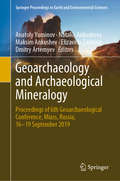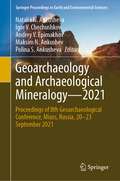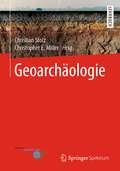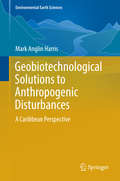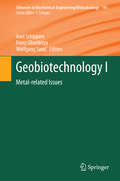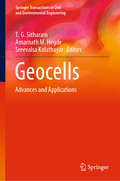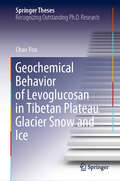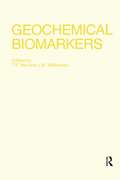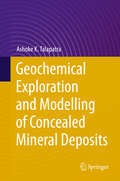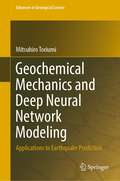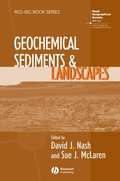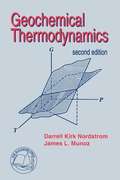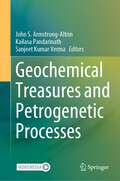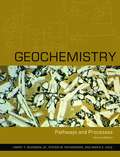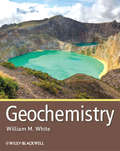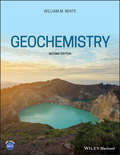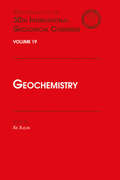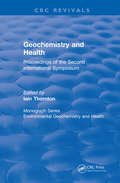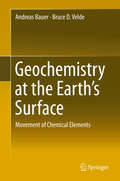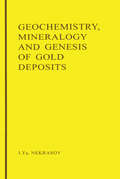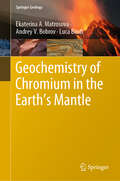- Table View
- List View
Geoarchaeology and Archaeological Mineralogy: Proceedings of 6th Geoarchaeological Conference, Miass, Russia, 16-19 September 2019 (Springer Proceedings In Earth And Environmental Sciences)
by Anatoly Yuminov Natalia Ankusheva Maksim Ankushev Elizaveta Zaykova Dmitry ArtemyevThis book presents general problems in geoarchaeology, and discusses geophysical solutions, X-ray fluorescence spectrometry applications, X-ray and isotope analyses and GIS technologies. It also examines practical reconstructions of technological processes used in ancient time, and investigates the use of minerals and rocks by ancient societies in the territories of modern Russia, Ukraine, Turkmenistan, and Tajikistan, as well as the characteristics of ores, metallurgical slags and data on the composition and impurities of archaeological metals. Intended for archaeologists, historians, museum workers and geologists studying noble metals and copper, the book is also a useful resource for students, graduate students, experts and anyone interested in the use of various minerals at different stages of humanity’s development.
Geoarchaeology and Archaeological Mineralogy: Proceedings of 6th Geoarchaeological Conference, Miass, Russia, 16–19 September 2019 (Springer Proceedings in Earth and Environmental Sciences)
by Anatoly Yuminov Natalia Ankusheva Maksim Ankushev Elizaveta Zaykova Dmitry ArtemyevThis book presents general problems in geoarchaeology, and discusses geophysical solutions, X-ray fluorescence spectrometry applications, X-ray and isotope analyses and GIS technologies. It also examines practical reconstructions of technological processes used in ancient time, and investigates the use of minerals and rocks by ancient societies in the territories of modern Russia, Ukraine, Turkmenistan, and Tajikistan, as well as the characteristics of ores, metallurgical slags and data on the composition and impurities of archaeological metals. Intended for archaeologists, historians, museum workers and geologists studying noble metals and copper, the book is also a useful resource for students, graduate students, experts and anyone interested in the use of various minerals at different stages of humanity’s development.
Geoarchaeology and Archaeological Mineralogy—2021: Proceedings of 8th Geoarchaeological Conference, Miass, Russia, 20–23 September 2021 (Springer Proceedings in Earth and Environmental Sciences)
by Natalia N. Ankusheva Igor V. Chechushkov Andrey V. Epimakhov Maksim N. Ankushev Polina S. AnkushevaThis book unites studies in the fields of archaeometry, geoarchaeology, and ancient technologies, based on cases from northern Eurasia, and includes archaeometallurgy, stone tools investigation, exploitation of geological resources in the past, bioarchaeology, residue analysis, pottery and lithics investigation, and use of the GIS in archaeology. The book of Springer Proceedings in Geoarchaeology and Archaeological Mineralogy contains selected papers presented at the 8th Geoarchaeology Conference, which took place during September 20–23, 2021, at the South Urals Federal Research Center, the Ural Branch of the Russian Academy of Sciences, Miass, Russia. A study of non-organic materials, rocks, minerals, ores, metals and metallurgical slags is a special focus of the book. Many papers also use modern analytical methods of isotopic, chemical, and mineralogical analysis to study the composition and structure of ancient materials and the technological practices of past human populations of Modern Russia, Ukraine, Turkmenistan, Tajikistan and Mongolia. The book is intended for archaeologists, historians, museum workers and geologists, as well as students, researchers from other disciplines and the general public interested in the interdisciplinary research in the field of archaeology and archaeological materials, strategies and techniques of past quarrying, mining, metallurgy and lithic technologies at different chronological periods in Eurasian steppe and adjacent forest zone.
Geoarchäologie
by Christian Stolz Christopher E. MillerDas erste deutschsprachige Lehrbuch der Geoarchäologie bietet einen hervorragenden Einstieg in eine vielfältige Disziplin, die der Archäologie wie auch der Physischen Geographie und anderen Geowissenschaften zugewandt ist. Der Überblick über die breite methodische Vielfalt der Geoarchäologie macht dieses Buch zum verlässlichen Nachschlagewerk für Studierende, Forschende und Praktiker. Es gehört daher zum unverzichtbaren Handwerkszeug für alle, die sich mit umwelt- und kulturgeschichtlichen Fragen auseinandersetzen. Geoarchäologische Fragestellungen zählen zu den populärsten Themen innerhalb der beteiligten Fächer. Durch die Entschlüsselung von Geoarchiven mithilfe moderner Datierungs- und Analysemethoden und interdisziplinären Ansätzen gelingt es, frühere Kulturen innerhalb ihrer Umwelt zu verorten und vergangene Landschaften zu rekonstruieren. Gerade im Zeitalter des globalen Wandels erscheint es umso wichtiger, Zustände, Prozesse und Dynamiken der Vergangenheit zu verstehen, nicht zuletzt um daraus gewonnene Erkenntnisse auf zukünftige Entwicklungen anwenden zu können. Das Buch wurde von Wissenschaftlerinnen und Wissenschaftlern von über 30 verschiedenen Universitätsinstituten, Behörden und Forschungseinrichtungen erarbeitet. Die Herausgeber sind Sprecher des 2004 gegründeten Arbeitskreises Geoarchäologie. Ihre über 70 Mitautorinnen und Mitautoren gehören zu den kundigsten Fachleuten ihrer Themen im deutschsprachigen Raum und darüber hinaus.
Geobiotechnological Solutions to Anthropogenic Disturbances
by Mark Anglin HarrisThis book offers a problem-and-solution approach toenvironmental remediation in mining, including the environmentally sustainableutilization of waste materials from the mining industry. It largely comprisesarticles published in Springer journals, which have been thoroughly revised andexpanded. With supplementary data and illustrations, it discusses specificproblem areas in relevant Caribbean locations and provides an overview ofgeotechnical and microbial solutions to prevent post-mining deterioration inthis area.
Geobiotechnology II
by Wolfgang Sand Franz Glombitza Axel SchippersThis book review series presents current trends in modern biotechnology. The aim is to cover all aspects of this interdisciplinary technology where knowledge, methods and expertise are required from chemistry, biochemistry, microbiology, genetics, chemical engineering and computer science. Volumes are organized topically and provide a comprehensive discussion of developments in the respective field over the past 3-5 years. The series also discusses new discoveries and applications. Special volumes are dedicated to selected topics which focus on new biotechnological products and new processes for their synthesis and purification. In general, special volumes are edited by well-known guest editors. The series editor and publisher will however always be pleased to receive suggestions and supplementary information. Manuscripts are accepted in English.
Geocells: Advances and Applications (Springer Transactions in Civil and Environmental Engineering)
by T. G. Sitharam Amarnath M. Hegde Sreevalsa KolathayarThis book is designed to serve as a comprehensive resource on cellular confinement systems or geocells, covering technologies and their applications in geotechnical engineering. The book discusses all aspects of geocells and related technologies, and covers the subjects from conceptual basics to recent advances. The chapters of this book are written by renowned international experts and its contents include detailed case studies from both academic and industry experts. This book is a one-stop reference work for academicians, students, and practicing engineers in the global geotechnical community.
Geochemical Behavior of Levoglucosan in Tibetan Plateau Glacier Snow and Ice (Springer Theses)
by Chao YouThis book focuses on geochemical behavior and ancient records of the specific biomarker levoglucosan in Tibetan glaciers, Based on samples from the Zangsegangri (ZSGR) ice cores obtained from the central Tibetan Plateau, it presents annually resolved levoglucosan records and fire changes over the past 430 years. It also discusses the interaction between fire, climate change, and human activities. This is the first effort to reconstruct annual resolution fire records in Tibetan ice, providing crucial information and substantially improved analytical methods toward a better understanding of past fire changes.
Geochemical Biomarkers
by T.F. Yen J.M. MoldowanFirst Published in 1988. Routledge is an imprint of Taylor & Francis, an informa company.
Geochemical Exploration and Modelling of Concealed Mineral Deposits: A Treatise On Exploration Of Concealed Land And Offshore Deposits
by Ashoke K. TalapatraThis book discusses potential mineral belts in various geotectonic regions around the globe, with a particular focus on concealed deposits, in order to highlight new areas for geochemical exploration and modelling. In recent years, the application of statistical methods using qualitative and, wherever possible, quantitative earth science data has become increasingly common for the evaluation of both offshore and terrestrial mineral resources. The book examines these approaches and provides examples from India, which are also applicable to deposits around the world, particularly those in South and South East Asia.The main objective of geochemical exploration and modelling is to present the geometry of the deposit in three dimensions. As such, the book describes the various conventional and non-conventional techniques of exploration geochemistry, especially in the context of concealed terrestrial and offshore mineral deposits. It serves as a guide for field geologists, geochemists, students, research scholars and scientists interested in earth science for the exploration of concealed mineral deposits and evaluation of their resources.
Geochemical Mechanics and Deep Neural Network Modeling: Applications to Earthquake Prediction (Advances in Geological Science)
by Mitsuhiro ToriumiThe recent understandings about global earth mechanics are widely based on huge amounts of monitoring data accumulated using global networks of precise seismic stations, satellite monitoring of gravity, very large baseline interferometry, and the Global Positioning System. New discoveries in materials sciences of rocks and minerals and of rock deformation with fluid water in the earth also provide essential information. This book presents recent work on natural geometry, spatial and temporal distribution patterns of various cracks sealed by minerals, and time scales of their crack sealing in the plate boundary. Furthermore, the book includes a challenging investigation of stochastic earthquake prediction testing by means of the updated deep machine learning of a convolutional neural network with multi-labeling of large earthquakes and of the generative autoencoder modeling of global correlated seismicity. Their manifestation in this book contributes to the development of human society resilient from natural hazards. Presented here are (1) mechanics of natural crack sealing and fluid flow in the plate boundary regions, (2) large-scale permeable convection of the plate boundary, (3) the rapid process of massive extrusion of plate boundary rocks, (4) synchronous satellite gravity and global correlated seismicity, (5) Gaussian network dynamics of global correlated seismicity, and (6) prediction testing of plate boundary earthquakes by machine learning and generative autoencoders.
Geochemical Rate Models
by J. Donald RimstidtThis well-organised, comprehensive reference and textbook describes rate models developed from fundamental kinetic theory and presents models using consistent terminology and notation. Major topics include rate equations, reactor theory, transition state theory, surface reactivity, advective and diffusive transport, aggregation kinetics, nucleation kinetics and solid-solid transformation rates. The theoretical basis and mathematical derivation of each model is presented in detail and illustrated with worked examples from real-world applications to geochemical problems. The book is also supported by online resources: self-study problems put students' new learning into practice, and spreadsheets provide the full data used in figures and examples, enabling students to manipulate the data for themselves. This is an ideal overview for graduate students, providing a solid understanding of geochemical kinetics. It will also provide researchers and professional geochemists with a valuable reference for solving scientific and engineering problems.
Geochemical Sediments and Landscapes
by David J. Nash Sue J. McLarenThis state-of-the-art volume reviews both past work and current research, with contributions from internationally recognized experts. The book is organized into fourteen chapters and designed to embrace the full range of terrestrial geochemical sediments. An up-to-date and comprehensive survey of research in the field of geochemical sediments and landscapes Discusses the main duricrusts, including calcrete, laterite and silcrete Considers deposits precipitated in various springs, lakes, caves and near-coastal environments Considers the range of techniques used in the analysis of geochemical sediments, representing a significant advance on previous texts
Geochemical Thermodynamics
by Darrell Kirk Nordstron James L. MunozGeochemical Thermodynamics (Second Edition), first published in 1994, takes the reader beyond the fundamental principles of thermodynamics to true geochemical applications. You will find the most complete coverage of the phase rule, chemography, solid solutions, ionic activities in the mixed aqueous electrolytes, and chemical potential diagrams for multiphase systems, plus other concepts central to geochemical theory. Throughout, there is an emphasis on environmentally relevant examples and applications. New sections include: - thermobarometry applications for igneous and metamorphic rocks; -expanding information on electrolytes at high temperature and pressure; - a new chapter on geochemical modeling; and substantially updated and expanded references. - a new appendix containing internally consistent enthalpies, entropies, heat capacities, and free energies, and equilibrium constants for a limited number of elements, ions, non-silicate minerals, and reactions at 298. 15K and 1 atmosphere that are particularly useful for hydrogeochemical modeling. 'This book presents the thermodynamics of geochemical systems, with applications ranging from groundwater to magmas. It should be of interest to a large number of such scientists wishing better acquaintance with the application of thermodynamics to practical problems. Geology There is a good balance of theory and application, and the book is superior to any other available text at the graduate or undergraduate level I can strongly recommend this book, having used it for a third-year undergraduate geochemistry course. It is most appropriate for physical geochemistry course with an emphases on thermodynamics. Researchers in petrology oriented fields will also find the book useful Canadian Mineralogist
Geochemical Treasures and Petrogenetic Processes
by John S. Armstrong-Altrin Kailasa Pandarinath Sanjeet Kumar VermaThis book highlights various aspects of geochemical and geological processes. In brief, it facilitates to understand the geochemical behavior of major, trace and rare earth elements in rocks to identify the magmatic processes involved in present-day magma generation and their relation to global tectonic regimes as well as geothermal studies. Therefore, the book provides a comprehensive view of the generation of magma types (mafic to felsic in composition) and their role in the petrogenesis. The book also covers the development of new geosoftware to effectively process the geochemical data before its interpretation.
Geochemistry
by Francis AlbarèdeIntroducing the essentials of modern geochemistry for students across the Earth and environmental sciences, this new edition emphasises the general principles of this central discipline. Focusing on inorganic chemistry, Francis AlbarÉde's refreshing approach is brought to topics that range from measuring geological time to the understanding of climate change. The author leads the student through the necessary mathematics to understand the quantitative aspects of the subject in an easily understandable manner. The early chapters cover the principles and methods of physics and chemistry that underlie geochemistry, to build the students' understanding of concepts such as isotopes, fractionation, and mixing. These are then applied across many of the environments on Earth, including the solid Earth, rivers, and climate, and then extended to processes on other planets. Three new chapters have been added – on stable isotopes, biogeochemistry, and environmental geochemistry. End-of-chapter student exercises, with solutions available online, are also included.
Geochemistry: Pathways and Processes
by Harry McSween Steven Richardson Maria UhleWritten expressly for undergraduate and graduate geologists, this book focuses on how geochemical principles can be used to solve practical problems. The attention to problem-solving reflects the authors'belief that showing how theory is useful in solving real-life problems is vital for learning. The book gives students a thorough grasp of the basic principles of the subject, balancing the traditional equilibrium perspective and the kinetic viewpoint. The first half of the book considers processes in which temperature and pressure are nearly constant. After introductions to the laws of thermodynamics, to fundamental equations for flow and diffusion, and to solution chemistry, these principles are used to investigate diagenesis, weathering, and natural waters. The second half of the book applies thermodynamics and kinetics to systems undergoing changes in temperature and pressure during magmatism and metamorphism. This revised edition incorporates new geochemical discoveries as examples of processes and pathways, with new chapters on mineral structure and bonding and on organic matter and biomarkers. Each chapter has worked problems, and the authors assume that the student has had a year of college-level chemistry and a year of calculus.Praise for the first edition"A truly modern geochemistry book.... Very well written and quite enjoyable to read.... An excellent basic text for graduate level instruction in geochemistry." —Journal of Geological Education"An up-to-date, broadly conceived introduction to geochemistry.... Given the recent flowering of geochemistry as an interdisciplinary science, and given the extent to which it now draws upon the fundamentals of thermodynamics and kinetics to understand earth and planetary processes, this timely and rigorous [book] is welcome indeed." —Geochimica et Cosmochimica Acta
Geochemistry: Pathways and Processes, Second Edition
by Mcsween Harry Y. Steven M. Richardson Maria UhleWritten expressly for undergraduate and graduate geologists, this book focuses on how geochemical principles can be used to solve practical problems. The attention to problem-solving reflects the authors' belief that showing how theory is useful in solving real-life problems is vital for learning. The book gives students a thorough grasp of the basic principles of the subject, balancing the traditional equilibrium perspective and the kinetic viewpoint.
Geochemistry
by William M. WhiteThis book provides a comprehensive introduction to the field of geochemistry. The book first lays out the 'geochemical toolbox': the basic principles and techniques of modern geochemistry, beginning with a review of thermodynamics and kinetics as they apply to the Earth and its environs. These basic concepts are then applied to understanding processes in aqueous systems and the behavior of trace elements in magmatic systems. Subsequent chapters introduce radiogenic and stable isotope geochemistry and illustrate their application to such diverse topics as determining geologic time, ancient climates, and the diets of prehistoric peoples. The focus then broadens to the formation of the solar system, the Earth, and the elements themselves. Then the composition of the Earth itself becomes the topic, examining the composition of the core, the mantle, and the crust and exploring how this structure originated. A final chapter covers organic chemistry, including the origin of fossil fuels and the carbon cycle's role in controlling Earth's climate, both in the geologic past and the rapidly changing present.Geochemistry is essential reading for all earth science students, as well as for researchers and applied scientists who require an introduction to the essential theory of geochemistry, and a survey of its applications in the earth and environmental sciences.Additional resources can be found at: www.wiley.com/go/white/geochemistry
Geochemistry (Wiley Works)
by William M. WhiteA Comprehensive Introduction to the “Geochemist Toolbox” – the Basic Principles of Modern Geochemistry In the new edition of William M. White’s Geochemistry, undergraduate and graduate students will find each of the core principles of geochemistry covered. From defining key principles and methods to examining Earth’s core composition and exploring organic chemistry and fossil fuels, this definitive edition encompasses all the information needed for a solid foundation in the earth sciences for beginners and beyond. For researchers and applied scientists, this book will act as a useful reference on fundamental theories of geochemistry, applications, and environmental sciences. The new edition includes new chapters on the geochemistry of the Earth’s surface (the “critical zone”), marine geochemistry, and applied geochemistry as it relates to environmental applications and geochemical exploration. ● A review of the fundamentals of geochemical thermodynamics and kinetics, trace element and organic geochemistry ● An introduction to radiogenic and stable isotope geochemistry and applications such as geologic time, ancient climates, and diets of prehistoric people ● Formation of the Earth and composition and origins of the core, the mantle, and the crust ● New chapters that cover soils and streams, the oceans, and geochemistry applied to the environment and mineral exploration In this foundational look at geochemistry, new learners and professionals will find the answer to the essential principles and techniques of the science behind the Earth and its environs.
Geochemistry: Proceedings of the 30th International Geological Congress, Volume 19
by Xie XuejinThis book is a collection of papers presented in the 30th International Geological Congress, held in Beijing, on geochemistry. The papers deal with topics on fluid-rock interaction, geochemical kinetics, geochemical mapping, environmental geochemistry, and exploration geochemistry.
Geochemistry and Health: Proceedings of the Second International Symposium (CRC Press Revivals)
by J.N. MartinThis volume comprises the proceedings of a three-day meeting held at the Royal Society, London, UK on 22,23,24 April 1987. The combined second International Symposium on Geochemistry and Health and 5th European Meeting of the Society for Environmental Geochemistry and Health was sponsored by the International Association of Geochemistry and Cosmochemistry, UMESCO, the Society for Environmental Geochemistry and Health and Imperial College with additional finacial supposrt from the UK Department of the Environment, the Royal Society, London and the Southern California Edison Company.
Geochemistry at the Earth's Surface
by Andreas Bauer Bruce D. VeldeGeochemistry at the surface of the earth is dominated by two somewhat antagonistic forces: chemical reactions which attempt to attain a steady state (equilibrium) and geological movement of materials in time and space which changes the parameters that control chemical equilibrium. Another aspect that is extremely important to earth surface geochemistry is the effect of plants on the chemical and physical stability of materials (soils). Plant systems in fact work against the normal chemical changes (loss of silica, potassium, etc. ) and the normal physical changes (stabilizing fine grained materials (clays) in the surface zones to avoid erosion). Biological effects are clearly seen in redox effects in the various parts of the earth surface movement cycle; soil formation, stream transport, sedimentation. This book attempts to outline these different parameters and their interactions as they affect earth surface geochemistry in order to give a better understanding of movement and accumulation of elements at the surface of the earth.
Geochemistry, Mineralogy and Genesis of Gold Deposits
by I.Y. NekrasovThe behaviour of gold in sedimentary, magmatic and postmagmatic processes are studied and 40 gold-bearing minerals including ten which were recently discovered are described. The results are presented of new experimental studies on phase relations in gold-sulphide systems. The solubility & form of gold migration in high-temperature chloride, sulphide and arsenic solutions are determined. Based on the new data, the genesis of gold deposits is studied and a geochemical classification proposed. This book is designed for specialists in the field of gold chemistry, geochemistry and mineralogy and for field geologists surveying and prospecting for gold.
Geochemistry of Chromium in the Earth’s Mantle (Springer Geology)
by Ekaterina A. Matrosova Andrey V. Bobrov Luca BindiThis book provides an analysis of an actual problem of the evolution of deep matter under the conditions of the upper mantle, transition zone, and uppermost lower mantle. This issue has a fundamental importance in geochemistry, petrology, mineralogy, and crystalochemistry of the mantle, at different depths. The authors discuss new experimental research on the composition and conditions of the chromium-bearing minerals genesis and their associations in the Earth’s mantle. The experimental data are compared with the natural mineral assemblages, allowing a refinement of the structure and composition of the deep Geospheres of the Earth. The results of the physicochemical experiments in the "MgO–SiO2–Cr2O3" model and the multicomponent systems play a major role in understanding the phase diagrams of these systems, the structural patterns of chromium-bearing phases and the influence of Cr on P-T parameters in the Earth’s mantle.
